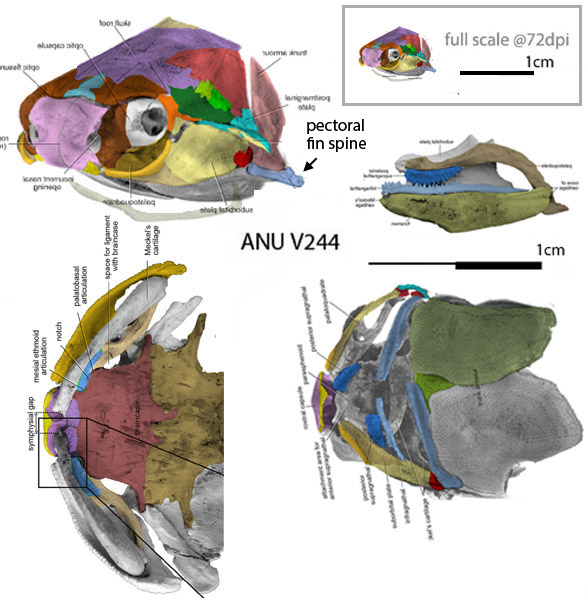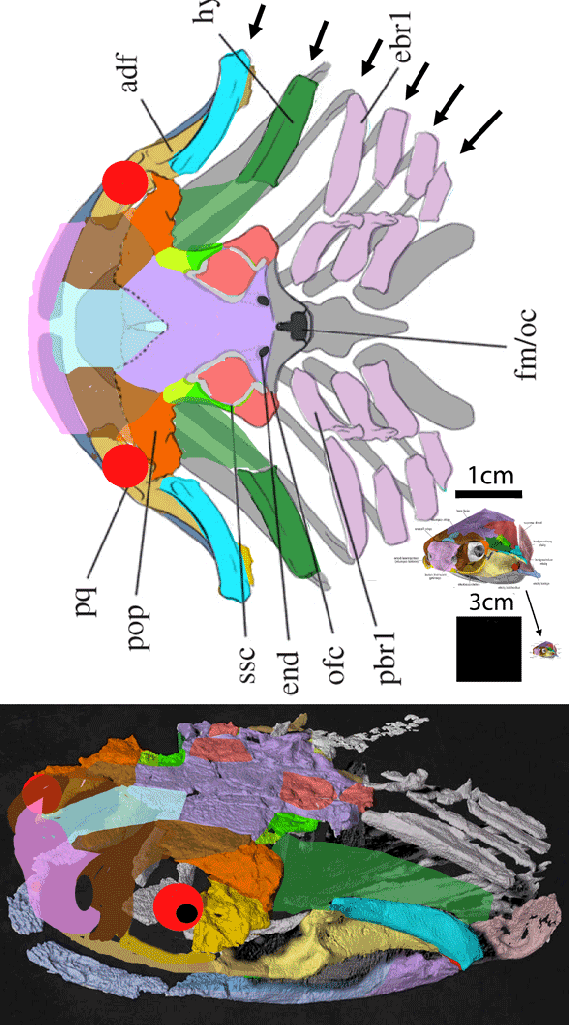Apparenly the shark ‘palatoquadrate’ = the placoderm preoperculum + jugal.
These two taxa, the tiny unnamed Early Devonian placoderm ANU V244 (Fig 1) and the Middle Devonian chondrichthyan, Gladbachius (Fig 1) apparently have something to teach us about shark and placoderm skull homology.

Unnamed genus
(ANU V244, Young, Lelièvre and Goujet 2001; Hu, Lu and Young 2017; Early Devonian) nests at the base of several clades in the LRT. That’s why it keeps cropping up. It is a phylogenetically miniaturized descendant of placoderms like Coccosteus. Here the palatine (blue) has a carpet of teeth. The dentary is a slender strip.The maxilla is not yet developed. The jugal (cyan) is curling over the preoperculum (light yellow) as in Gladbachus (Fig 2).

Gladbachus adentatus
(Heidtke & Krätschmer 2001; Burrow and Turner 2013; Coates et al. 2018; Middle Devonian, est. 54cm) was originally considered an ‘unfamiliar’ basal chondrichthyan close to acanthodians (spiny sharks). Here it nests near the base of the shark clade. This toothless or tiny-toothed taxon with a wide gape and flat skull was apparently a filter feeder with enormous gill bars. The unique holotype preserves the pelvic area. Compare Gladbachus to the earlier, smaller, narrower ANU V244 specimen (Fig 1).
Hopefully this bit of insight will help complete the fish subset of the LRT. These are the sort of problems that affect scores and resolution.
References
Coates MI, et al (7 co-authors) 2018. An early chondrichthyan and the evolutionary assembly of a shark body plan. Proceedings of the Royal Society B 285(1870):20172418.
Heidtke UHJ and Krätschmer K 2001. Gladbachus adentatus nov. gen. et sp., ein primitiver Hai aus dem Oberen Givetium (Oberes Mitteldevon) der Bergisch Gladbach – Paffrath-Mulde (Rheinisches Schiefergebirge). Mainzer geowiss. Mitt. 30, 105–122.
Hu Y, Lu J and Young 2017. New findings in a 400 million-year-old Devonian placoderm shed light on jaw structure and function in basal gnathostomes. Nature Scientific Reports 7: 7813 DOI:10.1038/s41598-017-07674-y
Young G C, Lelièvre H and Goujet D 2001. Primitive jaw structure in an articulated brachythoracid arthrodire (placoderm fish; Early Devonian) from southeastern Australia. J. Vertebr. Paleontol. 21, 670–678.
wiki/ANU V244 – not yet posted
wki/Gladbachus

If the structure you’re identifying as a jugal in placoderms is, in fact, the jugal, then it absolutely cannot be homologous with any part of the palatoquadrate in sharks. The jugal is a dermal bone and does not form in cartilage. The palatoquadrate is a cartilaginous structure.
Nothing shown on a tree will demonstrate otherwise. Jugals and palatoquadrates have different developmental origins.
There are probably also some bony vertebrates that have a jugal while retaining the part of the palatoquadrate you argue is homologous with the jugal.
Good point, Chris. Worth consideration.
Point 1: I’m labeling the jugal in a clade that is not related to tetrapods with a jugal. It’s a convergent jugal which makes scoring difficult, but not impossible. The placoderm jugal evolves to become the operculum in descendants like catfish and swordfish, distinct from the tetrapod line. So we’re working in a world of new definitions and identities.
Point 2: We’re not going to understand this situation when one side negates the other argument without offering an alternative solution. What is the other more correct way to go? In this case every topology of ANU V244 is also found in Gladbachus, after some resizing, stretching and the migration of the gill set posteriorly.
Helpful factoid: The Gladbacus authors reported, “The internal skeleton consists of calcified cartilage with no perichondral bone, yet the cartilage surface lacks the tightly connected tesserae that is a hallmark of chondrichthyan skeletal anatomy.”
Finally, the authors also mentioned, “scale shape, composition and histology are remarkable, as they resemble conditions observed in ‘placoderms’.
I’m working with shape and geography to identify skeletal elements. If I made a mistake, I need another road to travel. I hope you understand this need.
“We’re not going to understand this situation when one side negates the other argument without offering an alternative solution.”
Not true. I don’t have to provide the details of homologies for the dermal ossification of one species to know it’s not homologous with a cartilaginous structure in another.
This is basic homology assessment. This is stuff we do before we code taxa for phylogenetic analysis. I would recommend reading up on Colin Patterson’s arguments on homology for more on this.
By way of example – I don’t have to know whether the Second World War broke out in China or Poland to know it didn’t break out in Florida.
Your argument is akin to saying someone proved innocent of a crime by DNA evidence should remain in prison because we don’t know who actually committed the crime.
Chris: Do you know when extant shark ancestors changed from bone to cartilage? You indicated you did not have to “provide the details”, and as a teacher you would not withhold pertinent facts. So, with that issue on the table, let’s find out when sharks changed from bone to cartilage. BTW: scientific hypotheses are not in the same league as felonies… well, not all of them are. :-)
I don’t know the answer to that question, but it’s irrelevant to the point I’m making. Whether or not sharks ever had something like a placoderm “jugal,” any such structure would be developmentally unrelated to the palatoquadrate or chondrocranium. It would have been lost completely with no remaining evidence in living sharks.
A more interesting question is whether the placoderm “jugal” and my jugal are homologous. My understanding of the literature indicates a consensus against such homology. But homology between this “jugal” and any structure found in a shark can be rejected straight away.
By the same token, I don’t need a lot of phylogenetic information to know the shells of a turtle and a scallop have nothing to do with each other and aren’t homologous. They’re made from different substances and have completely different developmental origins.
I’ve tried to make this point with you before. Dermal bones don’t preform in cartilage. There will be no homology to be found between a dermal cranial bone and any cartilaginous structure. This is independent of phylogeny. Characters for such bones as the nasal and premaxilla cannot be scored for sharks, just as characters reflecting forelimb morphology cannot be coded for snakes and feather characters cannot be coded for rodents.
Consensus can be overturned. Just ask Galileo and Kepler. I’m going to keep looking for the transition from bones to cartilage in sharks. The Silurian was a long time ago.